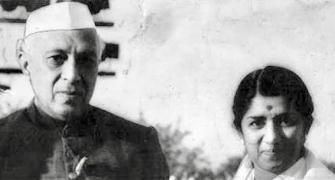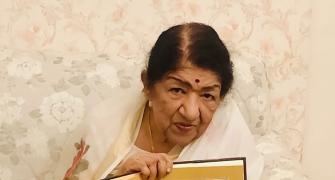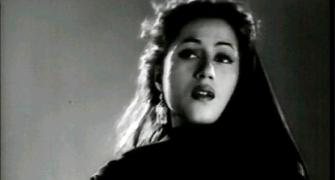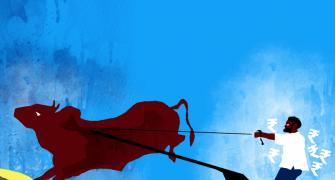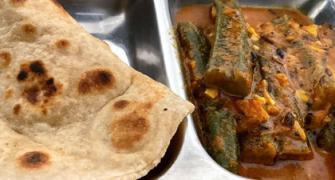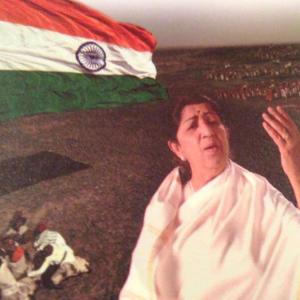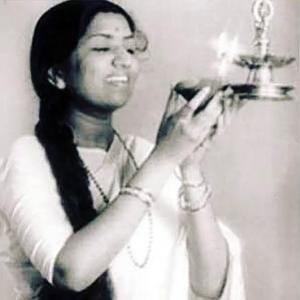One could be anywhere -- huddled around a transistor radio at home in the evenings, walking past a neighbour's house, or waiting at a bus stop and Lata Mangeshkar's voice would reach us.
Aseem Chhabra remembers The Legend.

Mala Sinha in a white sari stands up as the melodious composition by Madan Mohan starts, slow for a couple of seconds, until violins soar to accompany Raja Mehdi Ali Khan's lyrics. As Dharmendra gives a shy smile, we hear in Lata Mangeshkar's voice, Aap Ki Nazron Ne Samjha Pyar Ke Kabil Mujhe/
But those romantic glances between Mala Sinha and Dharmendra only seems incidental.
It is Lata's voice that takes command, defining the mood, the sensibilities of the scene.
That scene from Anpadh (1962) would have no feeling without Lata singing the song.

In Anupama (1966), Dharmendra walks in the midst of tall trees in Mahabaleshwar, with birds chirping early in the morning, intrigued by the haunting voice of Lata Mangeshkar singing Kuch Dil Ne Kaha, Kuch Bhi Nahin.
It is one of the most gentle songs in Hindi cinema, written by Kaifi Azmi and composed by Hemant Kumar.
Then, at a distance Sharmila Tagore appears looking gorgeous, playing with leaves, walking up and down the hills, as she becomes the 'owner' of the voice.
But Lata has already established the scene, the quiet, reflective mood of the song.

In the same way, her playful voice gives the extra oomph to Mumtaz teasing Rajesh Khanna singing Bindiya Chamkegi in Do Raaste (1969).
Later, Lata would say that the song for which she received one of her many Filmfare awards was not her favourite. But when she sang it, she poured her heart and soul into it, giving so much joy to the listeners.
Mumtaz could never be that hot without Lata's voice.
Leela Naidu was one of the prettiest Hindi film actresses, but her beauty and the sadness of the lonely housewife she plays in Anuradha (1960) takes on a deeper meaning when Lata Mangeshkar first says Hai, before she starts to sing Kaise Din Beete, Kaise Beeti Ratiya, Piya Janne Na, set to Ravi Shankar's music.
The same magic happens when Lata sings Hai Re Woh Din Kyun Naa Aaye in the same film.
I often wondered how I would react when Lata Mangeshkar would die.
What does death mean when her voice has populated the soundtrack of my childhood, teenage and now adult years?
Almost every Indian can make the claim, since Lata sang in so many languages.
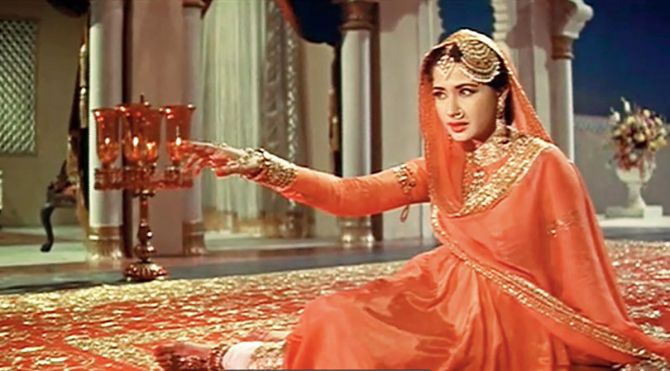
Lata was 92 and had lived a solid life.
I lost my mother last year. She was also 92.
I believe there is no sense in mourning such losses.
Instead, we should celebrate the people who gave so much meaning to our lives.
As cliched as it may sound, Lata Mangeshkar has really not left us. Her voice, which is how I mostly knew her, is easily accessible to me.
When I think of Lata, it is not through the black and white images of songs from Anpadh, Anupama, Anuradha or the spectacular coloured sets in the mujra sequences where Meena Kumari lip-syncs and dances to Chalte Chalte and Inhi Logo Nein Pakeezah (1972).

Before Doordarshan started broadcasting Chitrahaar in Delhi and Chhaya Geet in Bombay, we knew of Lata's voice through Vividh Bharati on All India Radio.
One could be anywhere -- huddled around a transistor radio at home in the evenings, before my father bought a boxy television set, walking past a neighbour's house, a paan shop or waiting at a bus stop and Lata Mangeshkar's voice would reach us.
Those were simpler times.
In the pre-cable TV and Internet days, we did not have too many forms of entertainment.
As children, we played outside our homes or read books to avoid going out during Delhi's hot summer days. Or we heard film music.
As a child, I first discovered Hindi cinema songs before I became a fan of Western pop groups such as the Beatles. So I almost always heard Lata's songs, followed by those sung by her sister Asha Bhosle and duets with the leading male singers of the time, Mohammed Rafi, Mukesh, Hemant Kumar, Kishore Kumar...
Lata's voice and the countless songs kept the nation moving ahead, united by the passion for cinema and music.
In my own Vividh Bharati -- the jukebox in my head -- it was Lata who spoke to me and sang exclusively for me, whether it was Main Kaa Karoon Ram Mujhe Budha Mil Gaya (Sangam, 1964), Yeh Sama, Sama Hai Yeh Pyar Ka (Jab Jab Phool Khile, 1964), Dikhayi Diye Yun, Ke Bekhud Kiya (Bazaar, 1982), or much later Didi Tera Devar Diwana (Hum... Aapke Hain Kaun, 1994).
Today, my jukebox will run a little longer. It has to sample six plus decades of Lata Mangeshkar's songs.


